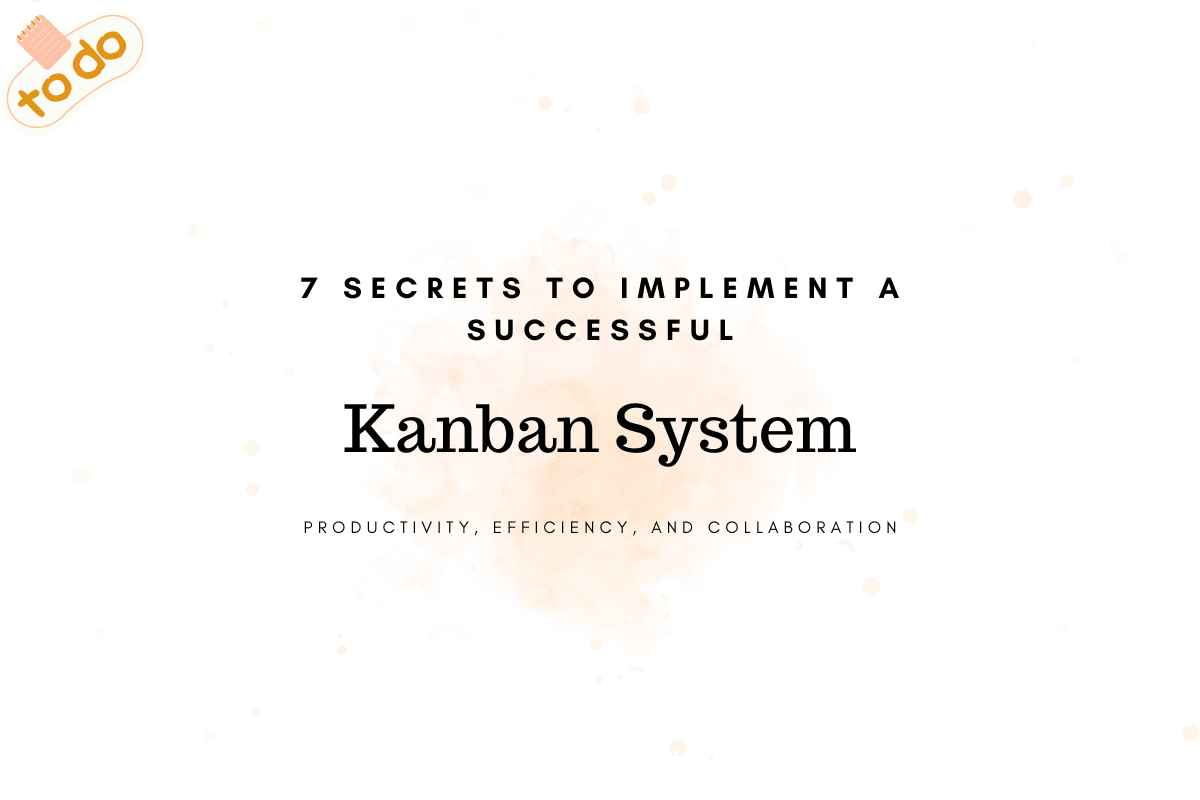Are you looking to enhance workflow efficiency, reduce waste, and enhance collaboration within your team? Implementing a Kanban system might be the answer. Kanban, an illustrated task management methodology, helps teams visualize their work, track progress, and streamline processes. This article will uncover seven secrets to successfully implementing a Kanban system that can transform your work.
Introduction
Before diving into the secrets of a successful Kanban system (Link), let’s better understand what Kanban is and its benefits.
Understanding Kanban
Kanban originated from the Japanese manufacturing industry and meant “visual signal” or “card.” It visually represents work in progress (WIP) using cards or sticky notes on a board. The primary goal of Kanban is to optimize workflow, increase efficiency, and reduce bottlenecks.
Benefits of Implementing a Kanban System
Implementing a Kanban system offers several benefits that can profoundly impact your team’s productivity and overall performance. Let’s explore some of these benefits:
Increased Efficiency
By visualizing your workflow and identifying potential bottlenecks, a Kanban system enables you to streamline your processes. With clear visibility, you can optimize resource allocation and eliminate time-consuming tasks, ultimately improving efficiency.
Improved Flow
Kanban emphasizes a pull-based approach, where work is only pulled into the system when there is capacity. This ensures a smooth workflow, reduces idle time, and prevents overburdening team members.
Reduced Waste
Through the visual representation of work and limiting work-in-progress (WIP), Kanban helps identify and eliminate wasteful activities. This results in reduced inventory, fewer delays, and improved overall productivity.
Now that we understand the benefits of implementing a Kanban system let’s delve into the secrets that will help you successfully adopt this methodology.
Also Read: The Astonishing Rise of Deep Fake Technology
7 Secrets to Implementing a Successful Kanban System
Secret 1: Define Your Workflow
Before implementing Kanban, it’s crucial to define your workflow clearly. Identify the steps involved, from ideation to completion. This provides a foundation for designing your Kanban board and visualizing your work effectively.
Secret 2: Visualize the Workflow
One of the key principles of Kanban is visualizing work. Create a physical or digital Kanban board representing your workflow stages and visualize your tasks using cards or sticky notes. This visual representation enhances transparency and improves communication among team members.
Secret 3: Set WIP (Work-in-Progress) Limits
Work-in-progress limits are a critical aspect of Kanban. Determine the maximum number of tasks or cards that can be in progress simultaneously at each workflow stage. This prevents overburdening team members and ensures a smooth flow of work.
Secret 4: Implement Pull-based Systems
Adopt a pull-based approach, where work is pulled into the system based on available capacity. When team members complete a task, they can pull the next task from the backlog. This helps maintain a sustainable pace of work and prevents work overload.
Secret 5: Measure and Improve
Continuously measure key metrics, such as lead time, cycle time, and throughput, to gain insights into your team’s performance. Analyze the data and identify areas for improvement. Regularly review and refine your Kanban system to achieve optimal results.
Secret 6: Foster Collaboration and Communication
Kanban promotes collaboration and communication among team members. Encourage cross-functional collaboration, share knowledge, and facilitate regular stand-up meetings to discuss progress, challenges, and improvements. This fosters a culture of teamwork and continuous learning.
Secret 7: Continuously Adapt and Evolve
Kanban is not a one-time implementation; it’s an iterative process. Embrace the mindset of continuous improvement and be open to adapting your Kanban system as you gain experience and encounter new challenges. Regularly reassess your workflow and make necessary adjustments to optimize your processes.
Overcoming Challenges in Implementing Kanban System
While implementing Kanban can bring numerous benefits, it’s essential to be aware of potential challenges that may arise during the process. Here are a few common challenges and strategies to overcome them:
Resistance to Change
Introducing any new methodology may need more support from team members accustomed to their existing working methods. To overcome this challenge, explain the benefits of Kanban and involve the team in the decision-making process.
Lack of Management Support
For a successful Kanban implementation, management support is crucial. Ensure management understands Kanban’s principles and benefits and actively supports the transition. This can be achieved through effective communication and demonstration of positive results.
Insufficient Training and Education
Proper training and education are vital for team members to understand the Kanban methodology and its effective implementation. Invest in training programs, workshops, and resources to equip your team with the necessary skills and knowledge.
Case Studies: Successful Kanban Implementations
To further illustrate the effectiveness of Kanban, let’s explore two case studies:
Company A: Streamlining Software Development
Company A implemented Kanban in their software development team. By visualizing their workflow, setting WIP limits, and adopting a pull-based system, they reduced lead time by 30% and significantly improved collaboration and delivery speed.
Company B: Optimizing Supply Chain Management
Company B implemented Kanban in its supply chain management processes. Through visualizing their workflow, measuring key metrics, and fostering collaboration, they reduced inventory costs by 25% and improved overall efficiency in their supply chain.
Conclusion
Implementing a successful Kanban system can revolutionize your team’s productivity, efficiency, and collaboration. By following the seven secrets discussed in this article and addressing potential challenges, you can unlock the full potential of Kanban and achieve remarkable results in your work processes.
FAQs
Q1. How long does it take to implement a Kanban system? The timeline for implementing Kanban depends on various factors, such as your workflow’s complexity and your team’s size. It can range from a few weeks to several months. Allowing sufficient time for planning, training, and gradual adoption is essential.
Q2. Can Kanban be used in industries other than manufacturing? Absolutely! Kanban’s principles and benefits can be applied to various industries beyond manufacturing. It has been successfully implemented in software development, marketing, healthcare, education, and many other sectors.
Q3. What are the key metrics to measure Kanban’s success? Key metrics to measure Kanban success include lead time (the time taken to complete a task), cycle time (the time it takes for a task to move through the workflow), and throughput (the number of tasks completed within a given time frame). These metrics provide insights into the efficiency and process improvement opportunities.
Q4. How do you handle changing priorities in a Kanban system? Kanban systems are designed to handle changing priorities effectively. When a new task or priority emerges, it can be added to the backlog. The team can then prioritize the task during backlog refinement sessions and pull it into the workflow when there is capacity.
Q5. Is Kanban suitable for large-scale projects? Yes, Kanban can be successfully applied to large-scale projects. However, it may require additional considerations, such as breaking the project into smaller work items, coordinating multiple teams, and ensuring effective communication and alignment.




